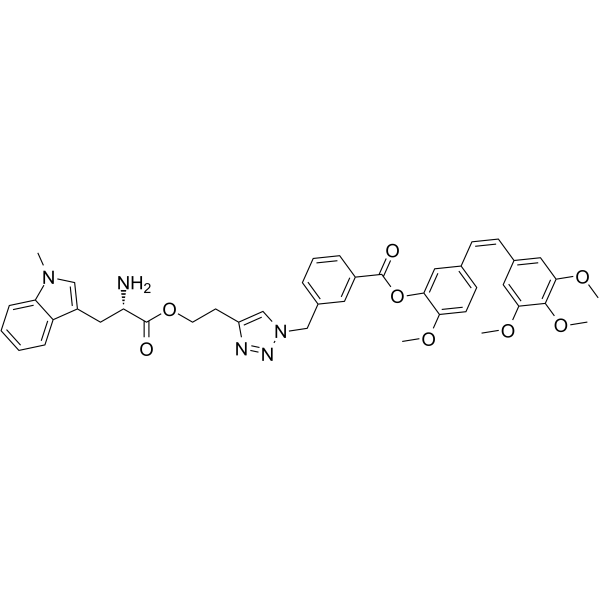| Description |
HI5 is a potent tublin and IDO inhibitor, with an IC50 value of 70 nM in HeLa cells. HI5 inhibit IDO expression and decrease kynurenine production, leading to stimulating T cells activation and proliferation. HI5 can inhibit tubulin polymerization and cell migration, cause G2/M phase arrest, and induce apoptosis via the mitochondrial dependent apoptosis pathway and cause reactive oxidative stress generation in HeLa cells. HI5 can be used for researching anticancer[1].
|
| Related Catalog |
|
| Target |
IC50: 70 nM in HeLa[1]
|
| In Vitro |
HI5 (0-10 μM; 72 hours) exhibits potent antiproliferative activity in HeLa, PC-3, A549 and HUVEC[1]. HI5 (0.1 and 0.5 μM; 24 hours) exhibits markedly disruption of microtubule organization in a concentration-dependent manner[1]. HI5 (0.5 μM; 24 hours) significantly up-regulates the expression level of Bax protein, while down-regulates the protein of Bcl-2, furthermore, markedly up-regulates the protein expressions of caspase-3 and PARP[1]. Cell Proliferation Assay Cell Line: HeLa, PC-3, A549 and HUVEC[1] Concentration: 0-10 μM Incubation Time: 72 hours Result: Exhibited potent antiproliferative activity in HeLa, PC-3, A549 and HUVEC with IC50s of 0.07 ± 0.005 μM, 0.46 ± 0.06 μM, 0.22 ± 0.10 μM, 1.52 ± 0.09 μM, respectively. Immunofluorescence Cell Line: HeLa[1] Concentration: 0.1 and 0.5 μM Incubation Time: 24 hours Result: Exhibited markedly disruption of microtubule organization in a concentration-dependent manner. Western Blot Analysis Cell Line: HeLa[1] Concentration: 0.5 μM Incubation Time: 24 hours Result: Significantly up-regulated the expression level of Bax protein, while down-regulated the protein of Bcl-2, furthermore, markedly up-regulated the protein expressions of caspase-3 and PARP.
|
| In Vivo |
HI5 (15 and 30 mg/kg; IV; daily, for 21 days) significantly inhibits tumor growth at a dose-dependent manner[1]. Animal Model: BALB/c nude mice (18-22 g, 5 week-old, injected with HeLa cells)[1] Dosage: 15 and 30 mg/kg Administration: IV; daily, for 21 days Result: Significantly inhibited tumor growth at a dose-dependent manner with inhibitory rates of 50.73% and 65.76% at doses of 15 and 30 mg/kg, respectively.
|
| References |
[1]. Hua S, et al. Dual-functional conjugates improving cancer immunochemotherapy by inhibiting tubulin polymerization and indoleamine-2,3-dioxygenase. Eur J Med Chem. 2020;189:112041.
|
